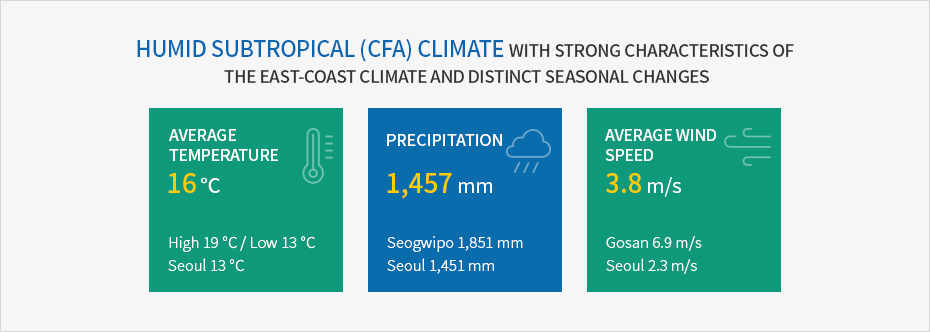Jeju’s Climatic Region
- Home
- General Status
- Jeju’s Geography and Geological Features
- Jeju’s Climatic Region
An Island Boasting Mild Weather, Significant Precipitation, and Strong Winds

- 평균기온 16℃ - 최고 19℃ / 최저 13℃, 서울 13℃
- 강수량 1,457mm - 서귀포 1,851mm, 서울 1,451mm
- 평균풍속 3.8m/s - 고산 6.9m/s, 서울 2.3m/s

Average temperature - Jeju 15.5℃, Seogwipo 16.2℃
Jeju, which is located at the east end of the Asian continent, is classified as a humid subtropical climate regime (Cfa type according to the Köppen climate classification system) in which the weather is warm even in winter and precipitation is evenly distributed throughout the year. The island has a shorter winter and longer summer compared to other regions.
Located at the center of the island, Halla Mountain rises almost 2,000m above sea level and gives the island diverse climatic features by area. Due to its geological location far away from the Korean peninsula, Jeju features unique weather patterns such as the development of sea breeze fronts, and a concentration of clean marine air.
Abundant precipitation – Total annual precipitation across the island reaching about 3.953 billion tons
North (Jeju City) 1,456.9mm / South (Seogwipo City) 1850.8mm / East (Seongsan) 1,840.9mm / West (Gosan) 1,094.7mmDespite its abundant precipitation, Jeju has no running streams due to porous soil and rock, which have resulted from the island’s volcanic origin, and because of the fact that heavy rains are concentrated in the summer months. This results in a distribution of diverse vegetation belts, fertile soil producing a variety of agricultural products, and rich underground water reservoirs.
The amount of rain on the island varies widely by region. Particularly, the eastern (Seongsan) and southern (Seogwipo) areas see 1.7 times more rain than the western area (Gosan). Precipitation is highest in August and lowest in December.
An island with unlimited wind resources
Jeju has long been known for its abundance of wind. The island is windy throughout the year and is frequently battered by gales.
The most important wind for Jeju is the northwest monsoon coming from Siberia in winter. The average wind speed in the southern (Seogwipo) and eastern (Seongsanpo) areas is a relatively mild 3.1m/s. On the other hand, the northern (Jeju City) and western (Gosan) areas average is 3.8m/s and 6.9m/s, respectively.
Gosan, the island’s westernmost village, sees more than 80 days with a maximum wind speed exceeding 13.9m/s. By contrast, Jeju City (northern area) sees such high winds for 14.5 days, Seogwipo (southern area) averages 2.8 days, and Seongsanpo (eastern area) just 0.9 day, showing the significant regional variations.
Such strong winds in Jeju have a significant impact on the lives of the local people and the natural environment, creating a unique island culture and beautiful scenery. In addition, Jeju has recently become an industrial hub for renewable energy based on its unlimited wind resources.